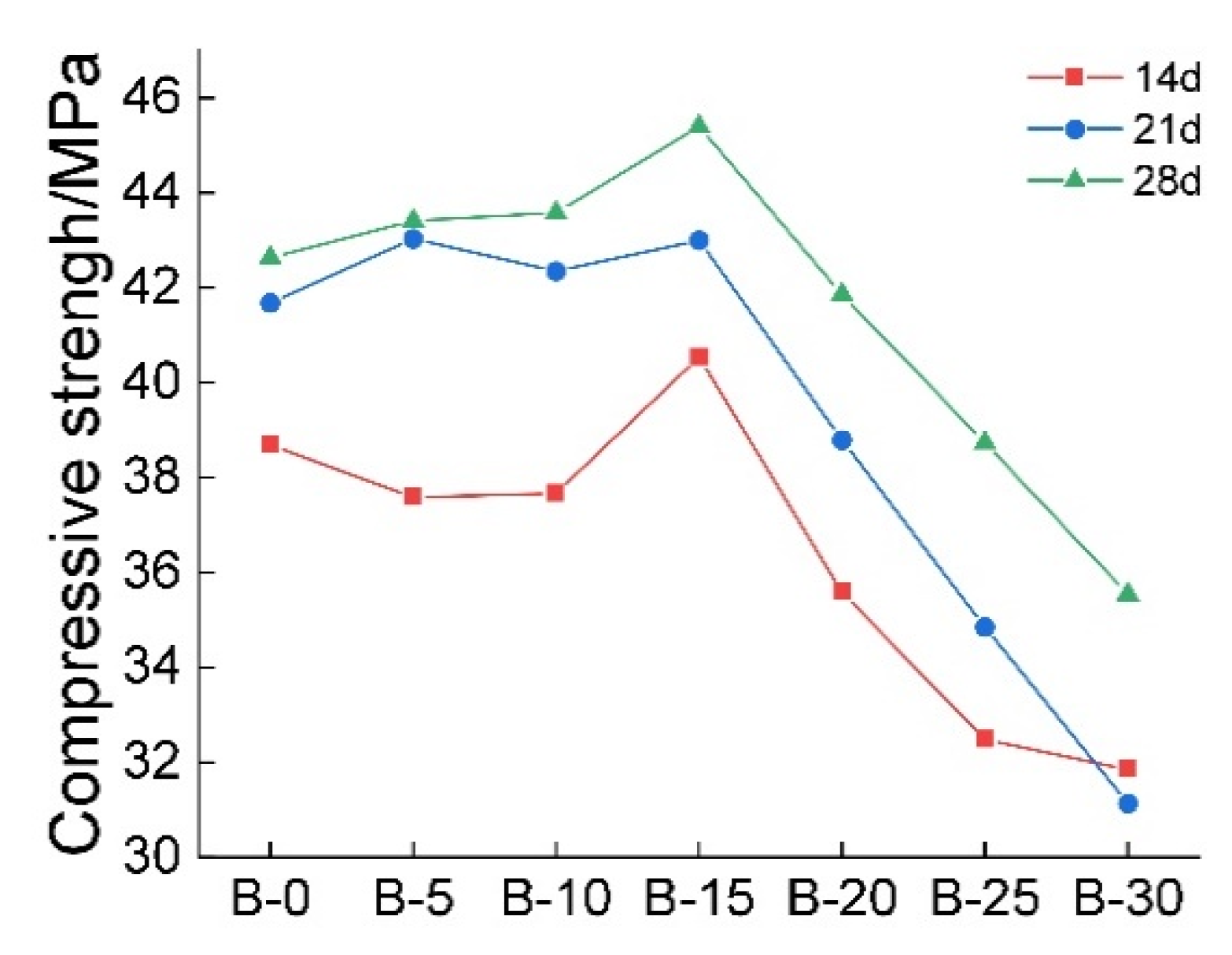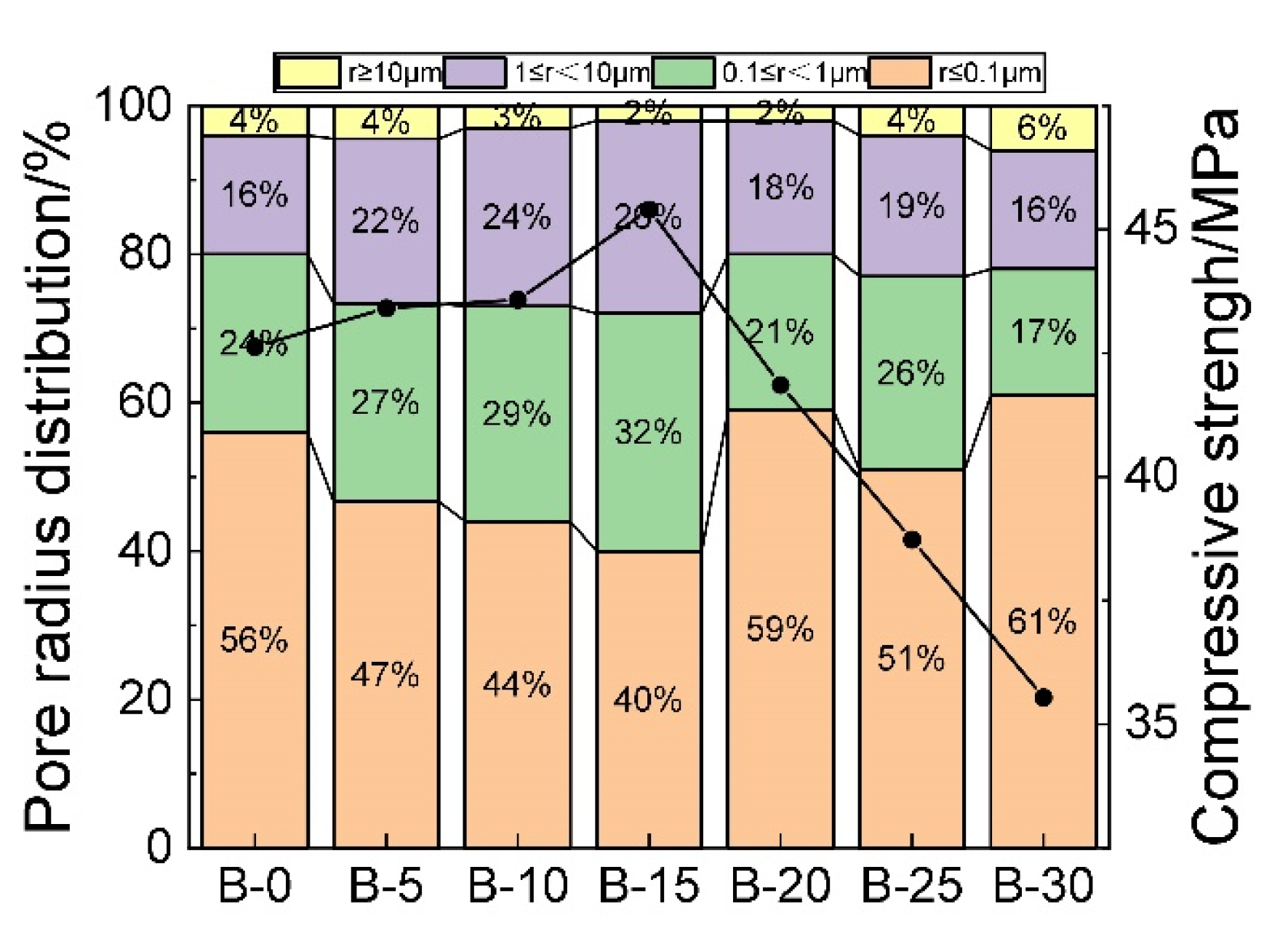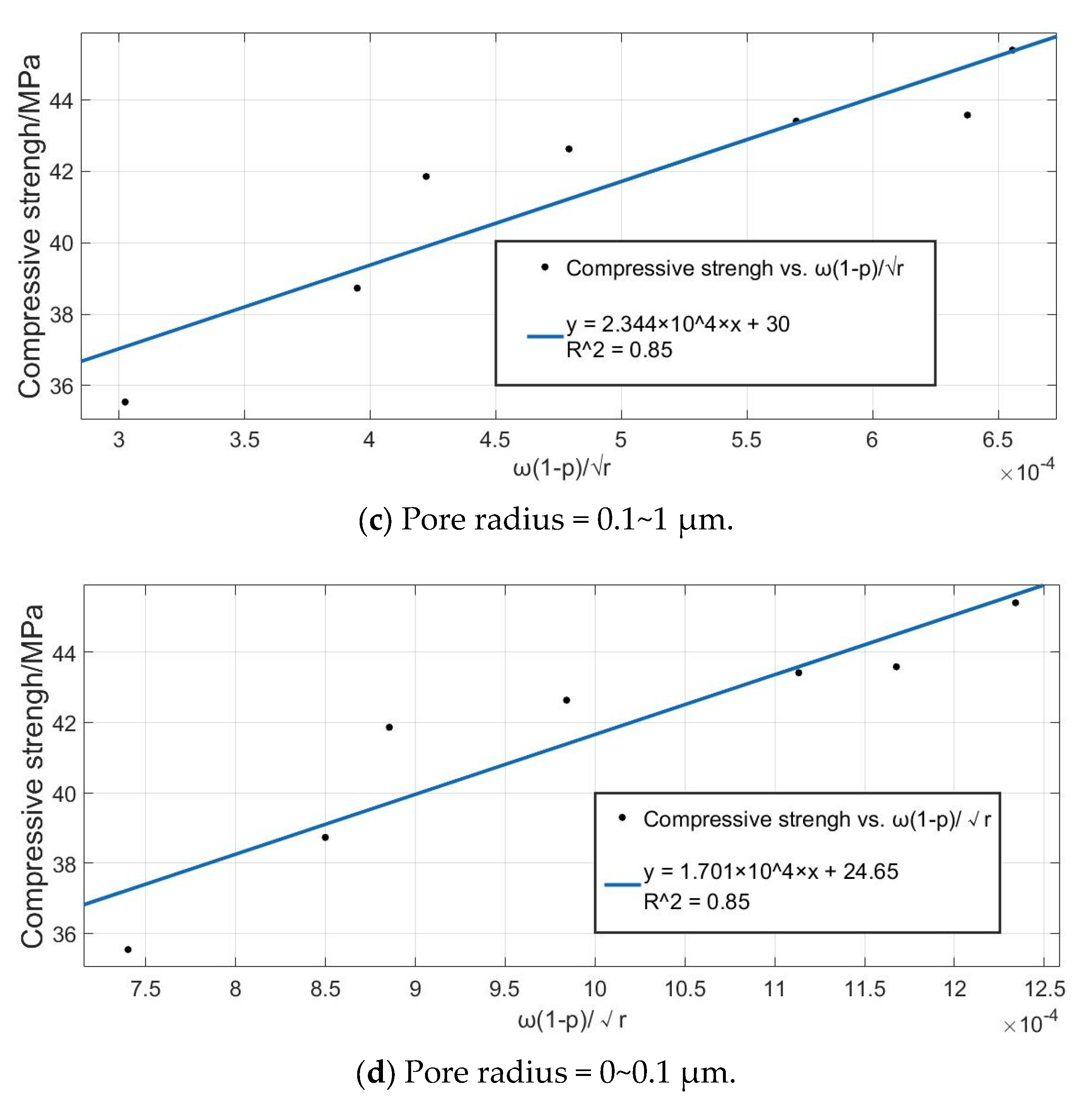Improvement Mechanism of the Mechanical Properties and Pore Structure of Rubber Lightweight Aggregate Concrete with S95 Slag
Abstract
:1. Introduction
2. Materials and Methods
2.1. Materials
2.2. Method
3. Results
3.1. Mechanical Properties and SEM Analysis of Rubber Powder Concrete
3.2. Gas Content—Mechanical Analysis
3.3. Mechanical Analysis of the Gas Content and Macroporous Porosity
3.4. Porosity—Mechanical Analysis
4. Conclusions
- S95 slag micro-powder can effectively improve the compressive strength of rubber powder lightweight aggregate concrete and has a good air-entraining effect. Among them, the 15% slag powder had the most obvious improvement advantage on the compressive strength of the concrete at 28 d.
- The results showed that the compressive strength of the concrete at 28 d had a decreasing trend with the increase in the gas content and macroporous porosity. Compared with the gas content, the macroscopic pore porosity had a more significant influence on the compressive strength of the rubber powder lightweight aggregate concrete at 28 d.
- The Atzeni pore-structure–strength model including the cement mass fraction showed that the correlation coefficient between a porosity of 0.1~1 μm and the compressive strength of the lightweight rubber powder aggregate concrete 28 d was optimal.
Author Contributions
Funding
Institutional Review Board Statement
Informed Consent Statement
Data Availability Statement
Conflicts of Interest
References
- Xu, D.; Cui, Y.; Li, H.; Yang, K.; Xu, W.; Chen, Y. On the future of Chinese cement industry. Cem. Concr. Res. 2015, 78, 2–13. [Google Scholar] [CrossRef]
- Xu, J.H.; Fleiter, T.; Eichhammer, W.; Fan, Y. Energy consumption and CO2 emissions in China’s cement industry: A perspective from LMDI decomposition analysis. Energy Policy 2012, 50, 821–832. [Google Scholar] [CrossRef]
- Yang, N.; Li, Y.-X.; Zhao, M.; LYU, C.; Liu, Z.-L.; Chen, S. Establishment of direct CO2 emission calculation model for cement clinker production enterprises. Adv. Clim. Chang. Res. 2021, 17, 79–87. [Google Scholar]
- He, J.Y.; He, J.; Wang, Y.T.; Fan, Y.B.; Shi, H.W.; Cai, B.F.; Yan, G. Study on the path of carbon dioxide emission peak in China’s cement industry. Res. Environ. Sci. 2022, 35, 347–355. [Google Scholar]
- Dong, L.; Haibin, Z. Impact of the 2030 Agenda for Sustainable Development on global and Chinese environmental governance. China Popul. Resour. Environ. 2016, 26, 8–15. [Google Scholar]
- Isaia, G.C.; Gastaldini, A.L.G. Concrete sustainability with very high amount of fly ash and slag. Rev. IBRACON Estrut. Mater. 2009, 2, 244–253. [Google Scholar] [CrossRef] [Green Version]
- Javali, S.; Chandrashekar, A.R.; Naganna, S.R.; Manu, D.S.; Hiremath, P.; Preethi, H.G.; Vinod Kumar, N. Eco-concrete for sustainability: Utilizing aluminium dross and iron slag as partial replacement materials. Clean Technol. Environ. Policy 2017, 19, 2291–2304. [Google Scholar] [CrossRef]
- Ulubeyli, G.C.; Artir, R. Sustainability for Blast Furnace Slag: Use of Some Construction Wastes. Procedia Soc. Behav. Sci. 2015, 195, 2191–2198. [Google Scholar] [CrossRef] [Green Version]
- Wang, Q.; Yan, P.; Yang, J.; Zhang, B. Influence of steel slag on mechanical properties and durability of concrete. Constr. Build. Mater. 2013, 47, 1414–1420. [Google Scholar] [CrossRef]
- Osborne, G.J. Durability of Portland blast-furnace slag cement concrete. Cem. Concr. Compos. 1999, 21, 11–21. [Google Scholar] [CrossRef]
- Bouikni, A.; Swamy, R.N.; Bali, A. Durability properties of concrete containing 50% and 65% slag. Constr. Build. Mater. 2009, 23, 2836–2845. [Google Scholar] [CrossRef]
- Qian, Z. Research progress of pumice and its exploitation and utilization. J. Mineral. Petrol. 1998, 111–115. [Google Scholar]
- Wang, X.X.; Liu, C.; Yin, L.Q.; Yan, C.W.; Liu, S.G. Freeze-thaw damage and life prediction model of natural pumice concrete. Bull. Chin. Ceram. 2021, 40, 98–105. [Google Scholar]
- Huo, J.; Yu, N.; Wang, T. Freeze-thaw damage model and Residual life prediction of pumice Aggregate concrete. Bull. Chin. Ceram. 2014, 33, 11–14. [Google Scholar]
- Huo, J.F.; Chu, J.J.; Yang, H. Experimental study on frost resistance of pumice mixed aggregate concrete in cold area. Bull. Chin. Ceram. 2013, 32, 1201–1205. [Google Scholar]
- Chidiac, S.E.; Panesar, D.K. Evolution of mechanical properties of concrete containing ground granulated blast furnace slag and effects on the scaling resistance test at 28days. Cem. Concr. Compos. 2008, 30, 63–71. [Google Scholar] [CrossRef]
- Bentz, D.P. Influence of water-to-cement ratio on hydration kinetics: Simple models based on spatial considerations. Cem. Concr. Res. 2006, 36, 238–244. [Google Scholar] [CrossRef]
- Zhang, J.X.; Zhang, J.H.; Wu, C.S. Study on properties and pore structure of recycled concrete. J. Build. Mater. 2006, 142–147. [Google Scholar]
- Jin, N.; Xianyu, J.; Guo, J. Study on the Relationship Model between concrete pore structure and Strength. J. Zhejiang Univ. Eng. Sci. 2005, 1680–1684. [Google Scholar]
- Zhong, J.; Yan, R.; Zhang, H.; Feng, Y.; Li, N.; Liu, X. Identification of fluid properties by NMR transverse relaxation time spectrum decomposition. Pet. Explor. Dev. 2020, 47, 691–702. [Google Scholar]
- Kleinberg, R.L.; Kenyon, W.E.; Mitra, P.P. Mechanism of NMR Relaxation of Fluids in Rock. J. Magn. Reson. Ser. A 1994, 108, 206–214. [Google Scholar] [CrossRef]
- Kewen, W.; Ning, L. Numerical simulation of rock pore-throat structure effects on NMR T2 distribution. Appl. Geophys. 2008, 5, 86–91. [Google Scholar] [CrossRef]
- Xiaoxiao, W.; Xiangdong, S.; Hailong, W.; Chu, G. Nuclear magnetic resonance analysis of concrete-lined channel freeze-thaw damage. J. Ceram. Soc. Jpn. 2015, 123, 43–51. [Google Scholar] [CrossRef] [Green Version]
- Zhang, N.; Zhao, F.F.; Wang, S.B.; Li, J.B.; Sun, D.Y. Review of NMR study on pore structure and seepage characteristics of rock. Water Resour. Hydropower Technol. 2018, 49, 28–36. [Google Scholar]
- Liu, Y.F.; Tang, D.Z.; Xu, H.; Li, S.; Zhao, J.L. Stress and deformation characteristics of pore fracture in coal rock based on nuclear magnetic resonance. J. China Coal Soc. 2015, 40, 1415–1421. [Google Scholar]
- Liu, W.; Xing, L. NMR Logging; Petroleum Industry Press: Beijing, China, 2011; ISBN 9787502187460. [Google Scholar]
- Jin, S.; Zhang, J.; Han, S. Fractal analysis of relation between strength and pore structure of hardened mortar. Constr. Build. Mater. 2017, 135, 1–7. [Google Scholar] [CrossRef]
- Liu, Q.; Shen, X.D.; Dong, R.X.; Wei, L.S.; Xue, H.J. Grey entropy analysis of the effect of pore structure on compressive strength of aeolian sand concrete. Trans. Chin. Soc. Agric. Eng. 2019, 35, 108–114. [Google Scholar]
- Li, W.; Wang, H.L.; Zhang, J.H.; Yang, H.; Wang, L.; Feng, S. Experimental study on mechanical properties and pore structure of gangue mixed aggregate concrete. J. Shandong Univ. Eng. Sci. 2022, 1–7. [Google Scholar]
- Kumar, R.; Bhattacharjee, B. Porosity, pore size distribution and in situ strength of concrete. Cem. Concr. Res. 2003, 33, 155–164. [Google Scholar] [CrossRef]










| Fitness (%) | Initial Set | Final Set | Stability of Volume | Loss on Ignition | Compressive Strength (MPa) | Rupture Strength, (MPa) | ||
|---|---|---|---|---|---|---|---|---|
| Min | Min | (%) | 3 d | 28 d | 3 d | 28 d | ||
| 1.3 | 135 | 175 | Qualified | 1.02 | 26.6 | 54.8 | 5.2 | 8.3 |
| Physical Properties | Bulk Density | Performance Density | Water Absorption, 1 h | Cylinder Compressive Strength | Crush Index |
|---|---|---|---|---|---|
| Pumice Stone | 690 kg/ | 1593 kg/ | 16.44% | 2.978 MPa | 39.6% |
| CaO | Al2O3 | SiO2 | C | Na2O | Fe2O3 | MgO | K2O | Other |
|---|---|---|---|---|---|---|---|---|
| 52 | 9 | 4 | 4 | 2 | 0.3 | 0.2 | 0.05 | 28.42 |
| Group | Cement (kg/m3) | Coal Ash (kg/m3) | Slag (kg/m3) | Lightweight Aggregate (kg/m3) | Sand (kg/m3) | Rubber Powder (kg/m3) | Water (kg/m3) | Water Reducer (kg/m3) |
|---|---|---|---|---|---|---|---|---|
| B-0 | 370 | 100 | 0 | 570 | 720 | 11.1 | 160 | 3.7 |
| B-5 | 346.5 | 100 | 23.5 | 570 | 720 | 11.1 | 160 | 3.7 |
| B-10 | 323 | 100 | 47 | 570 | 720 | 11.1 | 160 | 3.7 |
| B-15 | 299.5 | 100 | 70.5 | 570 | 720 | 11.1 | 160 | 3.7 |
| B-20 | 276 | 100 | 94 | 570 | 720 | 11.1 | 160 | 3.7 |
| B-25 | 252.5 | 100 | 117.5 | 570 | 720 | 11.1 | 160 | 3.7 |
| B-30 | 229 | 100 | 141 | 570 | 720 | 11.1 | 160 | 3.7 |
| Group | Area Under Spectrum | Macroscopic Pore Peak Area | |
|---|---|---|---|
| Area | Percent (%) | ||
| B-0 | 4160.740 | 58.666 | 1.41 |
| B-5 | 4013.325 | 58.996 | 1.47 |
| B-10 | 3624.697 | 51.471 | 1.42 |
| B-15 | 2948.322 | 37.444 | 1.27 |
| B-20 | 4185.862 | 59.858 | 1.43 |
| B-25 | 4501.329 | 67.070 | 1.49 |
| B-30 | 4793.851 | 80.043 | 1.67 |
Disclaimer/Publisher’s Note: The statements, opinions and data contained in all publications are solely those of the individual author(s) and contributor(s) and not of MDPI and/or the editor(s). MDPI and/or the editor(s) disclaim responsibility for any injury to people or property resulting from any ideas, methods, instructions or products referred to in the content. |
© 2023 by the authors. Licensee MDPI, Basel, Switzerland. This article is an open access article distributed under the terms and conditions of the Creative Commons Attribution (CC BY) license (https://creativecommons.org/licenses/by/4.0/).
Share and Cite
Guo, Z.; Wang, H.; Sun, S.; Feng, S.; Shu, L.; Tang, C. Improvement Mechanism of the Mechanical Properties and Pore Structure of Rubber Lightweight Aggregate Concrete with S95 Slag. Sustainability 2023, 15, 1008. https://doi.org/10.3390/su15021008
Guo Z, Wang H, Sun S, Feng S, Shu L, Tang C. Improvement Mechanism of the Mechanical Properties and Pore Structure of Rubber Lightweight Aggregate Concrete with S95 Slag. Sustainability. 2023; 15(2):1008. https://doi.org/10.3390/su15021008
Chicago/Turabian StyleGuo, Zihao, Hailong Wang, Song Sun, Shuai Feng, Libin Shu, and Chao Tang. 2023. "Improvement Mechanism of the Mechanical Properties and Pore Structure of Rubber Lightweight Aggregate Concrete with S95 Slag" Sustainability 15, no. 2: 1008. https://doi.org/10.3390/su15021008
APA StyleGuo, Z., Wang, H., Sun, S., Feng, S., Shu, L., & Tang, C. (2023). Improvement Mechanism of the Mechanical Properties and Pore Structure of Rubber Lightweight Aggregate Concrete with S95 Slag. Sustainability, 15(2), 1008. https://doi.org/10.3390/su15021008






